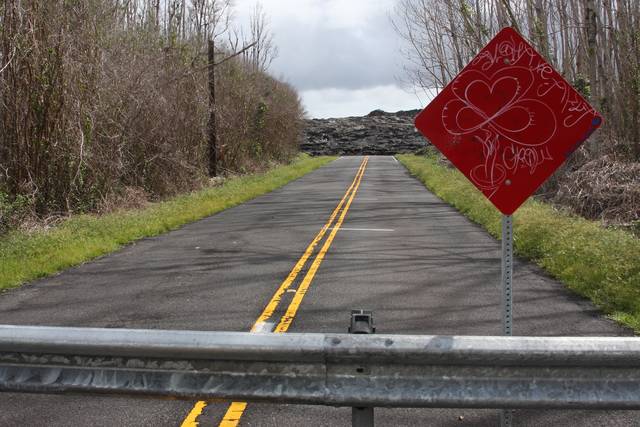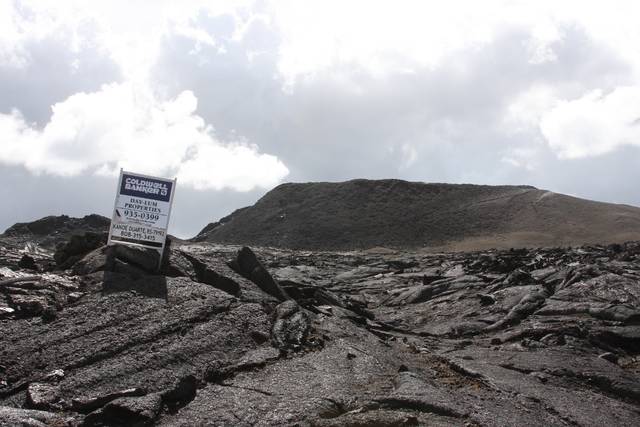Leilani Estates lawyers up: Association to sue county over access issues


An attorney for the Leilani Estates Community Association says the lava-ravaged subdivision will take Hawaii County to federal court over its response to the Kilauea eruption.
An attorney for the Leilani Estates Community Association says the lava-ravaged subdivision will take Hawaii County to federal court over its response to the Kilauea eruption.
Residents and board members have complained that they don’t have a seat at the table with county administrators and are concerned that they may be left to deal with an influx of visitors and law breakers if they lose the security checkpoint at the intersection of Leilani Avenue and Highway 130. The eruption started in the neighborhood May 3 and destroyed more than 700 homes throughout lower Puna over four months.
ADVERTISING
Attorney Mike Garbarino said the lawsuit, to be filed this week in U.S. District Court in Honolulu, will seek a preliminary injunction requiring the county to maintain the private security guards, whose contract expires Wednesday, until issues affecting the future of the subdivision are worked out.
“We’re associating it with these rights, with these property rights and due process rights of the association of the property owners here,” he told the Tribune-Herald following a meeting of the association’s board of directors on Saturday. “So long as security is needed in order for them to recover from this disaster, our position is that’s their constitutional right. That’s what the (Federal Emergency Management Agency) fund is for. You can’t pull the security away now.”
On top of that, the litigation could also involve whether the association should be granted temporary control of Leilani Avenue, the only public road in the neighborhood that now ends near fissure 8, so that it can manage access.
The pending lawsuit was announced at the meeting, attended by more than 50 people, nearly all of whom supported the action.
Jay Turkovsky, Leilani association president, said the lawsuit is needed because of a “total absence of communication” from the county.
After being informed of the lawsuit, Mayor Harry Kim said Saturday he thought it was premature. He said he plans to make a decision Monday about the security checkpoint.
“We have been working on this for more than a week, which option to choose,” he said.
Those options are: removing the checkpoint on Wednesday; extending it by one month and plan for what happens afterward; or keep it up until six months after the U.S. Geological Survey lowered the threat level, which occurred in early October.
Kim said FEMA has been paying 75 percent of the costs for the checkpoint, which runs about $100,000 a month. He said that aid is expected to end at the end of the month, meaning the county may have to foot the bill if the contract is extended.
Kim said safety and costs are both being considered.
“I think, I hope, they understand that we know it’s very hard for them,” he said. “And I hope that they remember from the first day I said every decision will be made not for individuals but for the good of the community. When you do that obviously there will be people not satisfied and I don’t blame them at all.”
In addition to Leilani, the eruption destroyed farms and also inundated Lanipuna Gardens and the Kapoho subdivisions, which were all each completely or nearly wiped out. Kim also lost a secondary home in Kapoho.
The only checkpoint to remain serves Leilani.
Asked what separates Leilani from other impacted areas that don’t have security, Garbarino said it’s a planned community with a legal organization and rules regarding covenants, conditions and restrictions, also known as CC&Rs. He said that gives the Leilani association responsibility to “protect the property values and help it recover.”
“We’re not dealing with unincorporated areas,” Garbarino said.
“… We’re talking about one of the gems of lower Puna. It still is (one of the best subdivisions) and we want it to be that into the future. That’s what this is about.”
In addition to concerns over crime and uncontrolled access, the association also wants the subdivision to benefit from any tourism that does occur.
While there was near unanimous support at the meeting for the lawsuit, some Leilani residents remain concerned about talk of gating portions of the subdivision if the checkpoint is lost.
Turkovsky said a committee is exploring that idea and that no decisions have been made. That would require a vote of the membership, he said.
Such a decision could threaten to split the community, since the first few streets on the upper side are not part of the association.
The association is currently assessing whether those residents want to become members, though it was acknowledged at the meeting that the interest appears to be low.
Meanwhile, Hawaiian Volcano Observatory scientists say they aren’t ruling out the possibility of the eruption resuming, though the longer there is no activity the less likely it is that it will continue at that location. No lava has been seen inside the fissures since September.
Inflation continues to occur on Kilauea’s Middle East Rift Zone from Pu‘u ‘O‘o to Highway 130 as magma enters the region.
Tina Neal, HVO scientist-in-charge, said there may be a “blockage” in the underground conduits keeping fresh magma from reaching Leilani and the rest of the Lower East Rift Zone. She said at the meeting that residents may only get hours or “tens of minutes” warning before lava returns to the area, if that occurs.
Additionally, Neal said there is no significant inflation or deflation at Kilauea’s summit, suggesting that magma could be bypassing the summit reservoir.
While still facing uncertainty, residents were nonetheless upbeat about the prospects of restoring their community.
Many cheered when resident Andy Andrews mentioned they were restarting the neighborhood movie night.
He said they need to move the community in a “positive direction” following the disaster, which the association estimates destroyed 253 homes in Leilani.
“Let’s make this fun, guys,” Andrews said.
Email Tom Callis at tcallis@hawaiitribune-herald.com.


